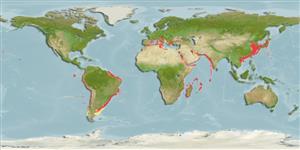Common names from other countries
Classification / Names / Names
Common names | Synonyms | Catalog of Fishes (gen., sp.) | ITIS | CoL | WoRMS
Environment: milieu / climate zone / depth range / distribution range
Ecology
Sessile; depth range 0 - 320 m (Ref. 865). Temperate
Circumglobal in tropical and temperate seas.
Length at first maturity / Size / Weight / Age
Maturity: Lm ? range ? - ? cm Max length : 10.0 cm H male/unsexed; (Ref. 3248)
Maximum depth from Ref. 116066. Epibenthic, encrusting, erect (Ref. 116066). Found in rocky subtidal (Ref. 116251), on giant kelp fronds, pilings, and boats hulls to a depth of 80 meters (Ref. 865). Suspension feeder (Ref. 116251). Part of fouling communities attached to raft frames in mariculture zones (Ref. 127121).
Life cycle and mating behavior
Maturity | Reproduction | Spawning | Eggs | Fecundity | Larvae
Members of the phylum Bryozoa are hermaphroditic. Both fertilization and egg brooding may either be internal or external.
Gappa, J.L. 2000. (Ref. 1202)
IUCN Red List Status (Ref. 130435)
CITES status (Ref. 108899)
Not Evaluated
Not Evaluated
Human uses
| FishSource |
Tools
More information
Age/Size
Growth
Length-weight
Length-length
Morphology
Larvae
Abundance
Internet sources
Estimates based on models
Preferred temperature
(Ref.
115969): 14.8 - 24.9, mean 19.7 (based on 400 cells).
Vulnerability
Low vulnerability (10 of 100).
Price category
Unknown.
